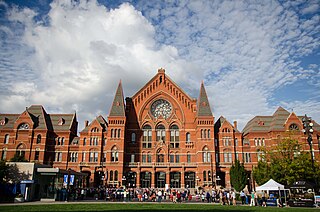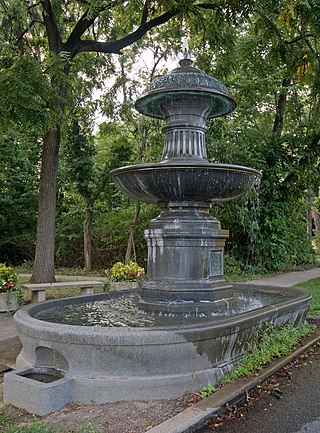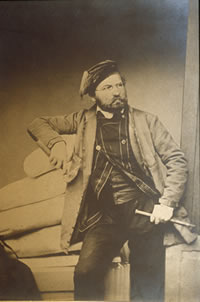
A fountain square is a park or plaza in a city that features a fountain. It may stand alone or as part of a larger public park.

Music Hall, commonly known as Cincinnati Music Hall, is a classical music performance hall in Cincinnati, Ohio, completed in 1878. It serves as the home for the Cincinnati Ballet, Cincinnati Symphony Orchestra, Cincinnati Opera, May Festival Chorus, and the Cincinnati Pops Orchestra. In January 1975, it was recognized as a National Historic Landmark by the U.S. Department of the Interior for its distinctive Venetian Gothic architecture. The building was designed with a dual purpose – to house musical activities in its central auditorium and industrial exhibitions in its side wings. It is located at 1241 Elm Street, across from the historic Washington Park in Over-the-Rhine, minutes from the center of the downtown area.

Cincinnati, Ohio is home to numerous structures that are noteworthy due to their architectural characteristics or historic associations. The city also boasts Fountain Square and a riverfront that is being revitalized under The Banks project.

Fountain Square is a city square in Cincinnati, Ohio, United States. Founded in 1871, it was renovated in 1971 and 2005 and currently features many shops, restaurants, hotels, and offices.

Hyde Park is one of the 52 neighborhoods of Cincinnati, Ohio. Originally established as a retreat for the city's wealthy, the neighborhood is predominately residential, with a central business district known as Hyde Park Square. The population was 14,193 at the 2020 census.

Washington Park is bounded by West 12th, Race and Elm Streets in the Over-the-Rhine neighborhood of Cincinnati, Ohio, United States. The park is owned and operated by the Cincinnati Park Board. The 6-acre (2.4 ha) park served as Presbyterian and Episcopal cemeteries before it was acquired by the city from 1858 to 1863.

The Probasco Fountain is a large fountain in Cincinnati, Ohio, United States. Built of bronze on a base of granite, the fountain was constructed in 1887 according to a design by Samuel Hannaford.

Henry Probasco House is a registered historic, single-dwelling house in the Clifton neighborhood of Cincinnati, Ohio, United States. It was built from 1859 to 1866 for Henry Probasco and his wife, Julia Amanda, on a 20-acre (8.1 ha) estate. Probasco is known for donating the Tyler Davidson Fountain to the city. The house was listed in the National Register on November 9, 1972.

Burnet Woods, owned and operated by the Cincinnati Park Board, is an 89.3-acre (361,000 m2) city park in Cincinnati, Ohio. The neighborhoods of Clifton and University Heights bound the park on three sides, while the University of Cincinnati west campus forms the southern border. Burnet Woods is bounded by Martin Luther King Drive on the south, Bishop Street on the east, Jefferson and Ludlow Avenues on the north, and Clifton Avenue on the west. Two streets — Brookline Avenue and Burnet Woods Drive — also pass through the park. The original park area was purchased by the city in 1872, with additional purchases made in 1881 and since. In 1875 an artificial lake was added. The park contains a bandstand constructed in 1911, The Lone Star Pavilion, Diggs Fountain Plaza, a playground area and the Trailside Nature Center. The Trailside Nature Center was a museum originally constructed as part of the Works Progress Administration.

Vine Street functions as Cincinnati's central thoroughfare. It bisects the downtown neighborhood, as well as the adjacent Over-the-Rhine neighborhood. The street also serves as the dividing line for the "east" and "west" sides of the city. All east-west addresses in the city start at zero at Vine Street.

Ferdinand von Miller was a German artisan who is noted for his furtherance of bronze founding.

Corryville is one of the 52 neighborhoods of Cincinnati, Ohio. It is located immediately east of the University of Cincinnati, southeast of Clifton, south and west of Avondale, northwest of Walnut Hills, and north of Mount Auburn. The population was 4,373 at the 2020 census.

Piatt Park is the oldest park in Cincinnati, Ohio. The urban park stretches two blocks between Elm Street and Vine Street on Garfield Place/8th Street. The park is owned and maintained by the Cincinnati Park Board.

Downtown Cincinnati is one of the 52 neighborhoods of Cincinnati, Ohio. It is the central business district of the city, as well the economic and symbiotic center of the Cincinnati metropolitan area. Originally the densely populated core of the city, the neighborhood was transformed into a commercial zone in the mid-20th century. The population was 5,835 at the 2020 census.
Simon Stevens Davis was an American politician from the U.S. state of Ohio. He served as the 19th Mayor of Cincinnati, Ohio.
The history of Over-the-Rhine is almost as deep as the history of Cincinnati. Over-the-Rhine's built environment has undergone many cultural and demographic changes. The toponym "Over-the-Rhine" is a reference to the Miami and Erie Canal as the Rhine of Ohio. An early reference to the canal as "the Rhine" appears in the 1853 book White, Red, Black, in which traveler Ferenc Pulszky wrote, "The Germans live all together across the Miami Canal, which is, therefore, here jocosely called the 'Rhine'." In 1875 writer Daniel J. Kenny referred to the area exclusively as "Over the Rhine". He noted, "Germans and Americans alike love to call the district 'Over the Rhine'."

August von Kreling was a German sculptor and painter born in Osnabrück. He studied with Peter von Cornelius, and in 1853 became director of the Academy of Fine Arts Nuremberg. He became a member of the Munich Academy in 1876, and died in Nuremberg in that same year.

Ferdinand Miller, from 1875 von Miller and from 1912 Freiherr von Miller was an ore caster, sculptor and director of the Academy of Fine Arts, Munich. He also held a seat in the Royal Bavarian House of Lords, the Reichsrat.

Friedrich "Fritz" Johann Baptist von Miller, known as Fritz von Miller was a German bronze caster, goldsmith and sculptor.

Henry Probasco was an American hardware magnate noted for the Tyler Davidson Fountain, Probasco Fountain and the Henry Probasco House. He had an interest in art and was selected as a "centennial commissioner" from Ohio.






















